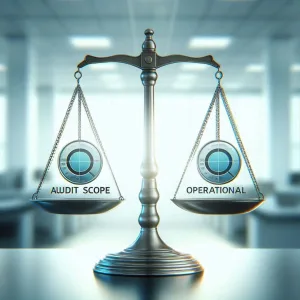The Sarbanes-Oxley Act (SOX), enacted in 2002, was a pivotal response to major financial scandals, such as those involving Enron and WorldCom. Its primary purpose is to protect investors by enhancing the accuracy and reliability of corporate disclosures. An integral part of this act is the SOX 404 audit, with Section 404 standing out as one of the most critical components aimed at improving corporate governance and accountability.
The Sarbanes-Oxley Act was designed to restore public confidence in the financial markets by imposing stringent regulations on public companies. It mandates that organizations establish robust internal controls and procedures for financial reporting, ensuring that financial statements are accurate and free from fraud. This legislation aims to enhance transparency and protect investors from misleading financial practices.
SOX Section 404 specifically requires public companies to assess and report on the effectiveness of their internal controls over financial reporting (ICFR). This section mandates that:
- Management Responsibility: Companies must include an Internal Control Report in their annual financial reports, affirming management’s responsibility for maintaining adequate internal control mechanisms for financial reporting [8].
- Assessment of Effectiveness: Management is required to evaluate the effectiveness of these controls and report any deficiencies [7][10].
- External Auditor Verification: External auditors must independently assess the internal controls to ensure that management’s evaluations are accurate, providing an additional layer of oversight [12][11].
The implementation of these requirements is not only a regulatory obligation but also a critical component of an organization’s risk management strategy.
Importance of Compliance for Organizations and Stakeholders
Compliance with SOX 404 is essential for organizations as it directly impacts their credibility and trustworthiness in the eyes of investors and stakeholders. The significance of adhering to these regulations includes:
- Investor Confidence: By ensuring accurate financial reporting, organizations can foster trust among investors, which is crucial for maintaining market stability and attracting capital.
- Risk Mitigation: Effective internal controls help identify and mitigate risks associated with financial reporting, reducing the likelihood of fraud and financial misstatements [9].
- Operational Efficiency: The process of establishing and maintaining internal controls can lead to improved operational efficiencies, as organizations streamline their financial reporting processes and enhance accountability.
SOX 404 audits play a vital role in the internal audit landscape, serving as a foundation for proactive compliance and risk management. By understanding the requirements and significance of SOX 404, internal auditors and risk management professionals can better navigate the complexities of compliance and contribute to their organizations’ overall governance framework.
The Role of Continuous Monitoring in Internal Audits
In the realm of internal audits, particularly concerning SOX 404 compliance, continuous monitoring has emerged as a pivotal strategy for enhancing audit effectiveness. This section will define continuous monitoring, highlight its benefits, and discuss the significance of real-time data analysis in the context of SOX 404 audits.
Definition of Continuous Monitoring
Continuous monitoring refers to the ongoing assessment of an organization’s internal controls and financial reporting processes. Unlike traditional auditing, which typically occurs at set intervals (e.g., annually or quarterly), continuous monitoring involves the real-time evaluation of controls and processes. This proactive approach allows organizations to identify and address potential issues as they arise, rather than waiting for periodic audits to uncover them. Continuous monitoring integrates automated tools and technologies to track compliance and performance metrics consistently, ensuring that any deviations from established standards are promptly detected and rectified.
Benefits of Continuous Monitoring in Enhancing Audit Quality and Reliability
The implementation of continuous monitoring offers several advantages that significantly enhance the quality and reliability of internal audits:
- Timely Detection of Issues: Continuous monitoring enables organizations to identify control deficiencies or compliance issues in real-time, allowing for immediate corrective actions. This reduces the risk of material misstatements in financial reporting, which is a critical aspect of SOX 404 compliance [2][12].
- Increased Audit Efficiency: By automating the monitoring process, internal auditors can focus their efforts on areas that require deeper analysis rather than spending time on routine checks. This efficiency not only saves time but also allows auditors to allocate resources more effectively [9][10].
- Enhanced Risk Management: Continuous monitoring provides a comprehensive view of the organization’s risk landscape. By regularly assessing controls, organizations can adapt to changing risks and ensure that their internal control systems remain robust and effective [8][12].
Real-Time Data Analysis and Its Relevance to SOX 404 Compliance
Real-time data analysis plays a crucial role in the context of SOX 404 compliance. The ability to analyze data as it is generated allows organizations to:
- Ensure Accurate Financial Reporting: Continuous monitoring facilitates the ongoing evaluation of financial data, ensuring that any discrepancies are identified and addressed immediately. This is essential for maintaining the integrity of financial reporting, a core requirement of SOX 404 [5][15].
- Support External Auditors: With continuous monitoring in place, external auditors can rely on up-to-date information regarding the effectiveness of internal controls. This not only streamlines the audit process but also enhances the credibility of the audit findings [3][7].
- Foster a Culture of Compliance: By integrating continuous monitoring into the organizational culture, companies can promote a proactive approach to compliance. Employees become more aware of the importance of internal controls and are encouraged to adhere to established procedures, ultimately leading to a stronger compliance posture [4][11].
Continuous monitoring represents a significant advancement in internal audit practices, particularly for SOX 404 compliance. By embracing this proactive approach, organizations can enhance the effectiveness of their audits, improve risk management, and ensure the reliability of their financial reporting processes.
Implementing Continuous Monitoring for SOX 404 Audits
Continuous monitoring is an essential strategy for enhancing the effectiveness of SOX 404 audits. By integrating this proactive approach, internal auditors can ensure that internal controls over financial reporting are not only in place but also functioning optimally. Here are key points to consider when implementing continuous monitoring in your SOX 404 audit framework:
Steps to Integrate Continuous Monitoring
- Assess Current Controls: Begin by evaluating the existing internal control framework to identify areas that require continuous monitoring. This assessment should focus on the effectiveness of current controls and any gaps that may exist in compliance with SOX requirements [4].
- Develop a Monitoring Plan: Create a structured plan that outlines how continuous monitoring will be integrated into the audit process. This plan should detail the frequency of monitoring activities, the specific controls to be monitored, and the resources required for implementation.
- Engage Stakeholders: Involve key stakeholders, including management and IT, to ensure that the monitoring plan aligns with organizational goals and that there is buy-in for the necessary changes.
- Implement Technology Solutions: Leverage technology to automate monitoring processes. This can include using software tools that facilitate real-time data analysis and reporting, which can significantly reduce manual effort and increase accuracy [11].
Tools and Technologies for Continuous Monitoring
- Document Management Systems: These systems can help maintain and provide documentation that demonstrates ongoing compliance with SOX objectives. They serve as tangible evidence of the organization’s commitment to adhering to SOX requirements [7].
- Data Analytics Tools: Utilize data analytics to monitor transactions and controls continuously. These tools can help identify anomalies or trends that may indicate control deficiencies, allowing for timely intervention.
- Automated Reporting Solutions: Implement automated reporting tools that can generate real-time reports on the status of internal controls. This enables auditors to quickly assess compliance and make informed decisions [10].
Establishing Key Performance Indicators (KPIs) and Metrics
Define Relevant KPIs: Establish KPIs that are directly linked to the effectiveness of internal controls. These may include metrics such as the number of control failures, the time taken to resolve issues, and the frequency of monitoring activities [13].
Set Benchmarks: Create benchmarks for each KPI to measure performance against industry standards or historical data. This will help in identifying areas for improvement and ensuring that the monitoring process is effective [14].
Regular Review and Adjustment: Continuously review the established KPIs and metrics to ensure they remain relevant and effective. Adjust them as necessary based on changes in the business environment or regulatory requirements [11].
By implementing continuous monitoring strategies, internal auditors can enhance the effectiveness of SOX 404 audits, ensuring that internal controls are not only compliant but also robust and responsive to emerging risks. This proactive approach not only aids in compliance but also contributes to the overall integrity of financial reporting within the organization.
Challenges in Continuous Monitoring Implementation
Implementing continuous monitoring in SOX 404 audits presents several challenges that organizations must navigate to enhance audit effectiveness. Below are some common obstacles, along with strategies to address them:
Common Obstacles Organizations Face
- Complexity of Integration: Organizations often struggle with integrating continuous monitoring systems with existing processes and technologies. This complexity can lead to disruptions in operations and resistance from staff who are accustomed to traditional methods of auditing [7].
- Resource Intensity: Continuous monitoring requires significant resources, including time, personnel, and technology. Many organizations may find it challenging to allocate these resources effectively, especially if they are already stretched thin [11].
- Data Overload: The volume of data generated through continuous monitoring can be overwhelming. Organizations may face difficulties in analyzing this data effectively to identify meaningful insights and actionable items.
Addressing Data Privacy and Security Concerns
- Implementing Robust Security Protocols: Organizations must prioritize data privacy by implementing strong security measures. This includes encryption, access controls, and regular audits of data handling practices to ensure compliance with regulations [4].
- Transparency and Communication: Clear communication about how data will be used and protected can alleviate concerns among stakeholders. Providing training and resources to employees about data privacy can foster a culture of compliance and security awareness [12].
- Regular Risk Assessments: Conducting regular risk assessments can help identify potential vulnerabilities in data handling and monitoring processes. This proactive approach allows organizations to address issues before they escalate into significant problems.
Change Management Strategies to Overcome Resistance from Stakeholders
- Engaging Stakeholders Early: Involving key stakeholders in the planning and implementation phases can help mitigate resistance. By soliciting their input and addressing their concerns, organizations can foster a sense of ownership and commitment to the continuous monitoring initiative [2].
- Providing Training and Support: Offering comprehensive training programs can equip employees with the necessary skills to adapt to new monitoring systems. Ongoing support and resources can help ease the transition and build confidence in using new technologies [3].
- Demonstrating Value: Highlighting the benefits of continuous monitoring, such as improved compliance, reduced fraud risk, and enhanced operational efficiency, can help persuade stakeholders of its importance. Sharing success stories and metrics from pilot programs can further reinforce the value proposition [4][5].
By addressing these challenges head-on, organizations can successfully implement continuous monitoring in their SOX 404 audits, leading to more proactive compliance and enhanced risk management.
Future Trends in SOX 404 Audits and Continuous Monitoring
As organizations strive for enhanced compliance and risk management, the landscape of SOX 404 audits is evolving significantly. Continuous monitoring is becoming a pivotal strategy in this transformation, driven by emerging technologies and a shift towards proactive compliance. Here are some key trends shaping the future of SOX 404 audits and continuous monitoring:
Emerging Technologies and Their Potential Impact
- Adoption of Automation: Organizations are increasingly leveraging automation tools to streamline SOX compliance processes. This shift reduces administrative burdens and allows for real-time insights into control statuses, enhancing the overall effectiveness of audits [2][10].
- Continuous Control Monitoring (CCM): Leading firms are moving away from traditional manual, sample-based control testing towards Continuous Control Monitoring. This approach automates compliance checks, thereby reducing risks and costs associated with SOX audits [5].
The Role of Artificial Intelligence and Machine Learning
- Enhanced Audit Efficiency: AI and machine learning are revolutionizing the audit process by enabling quicker and more effective audits. These technologies facilitate the identification of compliance risks with minimal human intervention, allowing internal auditors to focus on strategic advisory roles rather than just testing [9].
- Fraud Detection: AI’s capabilities extend to fraud detection, where machine learning algorithms can analyze vast amounts of data to identify anomalies that may indicate compliance issues. This proactive approach significantly enhances the effectiveness of SOX 404 audits [12].
Anticipated Changes in Regulatory Requirements and Best Practices
- Evolving Regulatory Landscape: As the business environment changes, so too do regulatory requirements. Internal audit teams must stay ahead of these changes by adopting SOX readiness strategies that not only comply with existing regulations but also prepare for future developments [3][6].
- Focus on Continuous Monitoring: The trend towards continuous monitoring is expected to solidify as a best practice in SOX 404 audits. This approach not only improves compliance posture but also enhances operational efficiency by allowing for timely issue detection and resolution [8].
The future of SOX 404 audits is poised for significant transformation through the integration of continuous monitoring and advanced technologies. Internal auditors and risk management professionals must embrace these changes to enhance their compliance frameworks and ensure robust financial integrity. By leveraging automation, AI, and machine learning, organizations can proactively address compliance risks and adapt to the evolving regulatory landscape.
Conclusion
In the realm of SOX 404 audits, continuous monitoring emerges as a pivotal strategy that significantly enhances the effectiveness of compliance efforts. By integrating continuous monitoring into the audit process, organizations can ensure that their internal controls over financial reporting are not only compliant but also resilient against potential risks. This proactive approach allows for real-time insights into control effectiveness, enabling timely adjustments and reducing the likelihood of compliance failures.
Key takeaways regarding the importance of continuous monitoring in SOX 404 audits include:
- Enhanced Control Effectiveness: Continuous monitoring facilitates ongoing assessment of internal controls, ensuring they function as intended and adapt to changing business environments. This aligns with the requirements of SOX Section 404, which emphasizes the need for robust internal control frameworks to maintain accurate financial reporting [6][10].
- Proactive Compliance Strategies: Internal auditors are encouraged to embrace proactive compliance strategies that leverage continuous monitoring. This shift not only helps in identifying issues before they escalate but also fosters a culture of accountability and transparency within organizations [14][15].
- Staying Informed: The landscape of auditing is continually evolving, with advancements in technology and methodologies. Internal auditors and risk management professionals should remain informed about these changes to effectively implement continuous monitoring practices and enhance their audit processes [12].
In conclusion, adopting continuous monitoring in SOX 404 audits is not merely a best practice; it is a necessary evolution in the approach to compliance. By prioritizing this strategy, internal auditors can significantly improve their audit effectiveness, ensuring that organizations not only meet regulatory requirements but also build a foundation for sustainable financial integrity.
Find out more about Shaun Stoltz https://www.shaunstoltz.com/about/
This post was written by an AI and reviewed/edited by a human.



